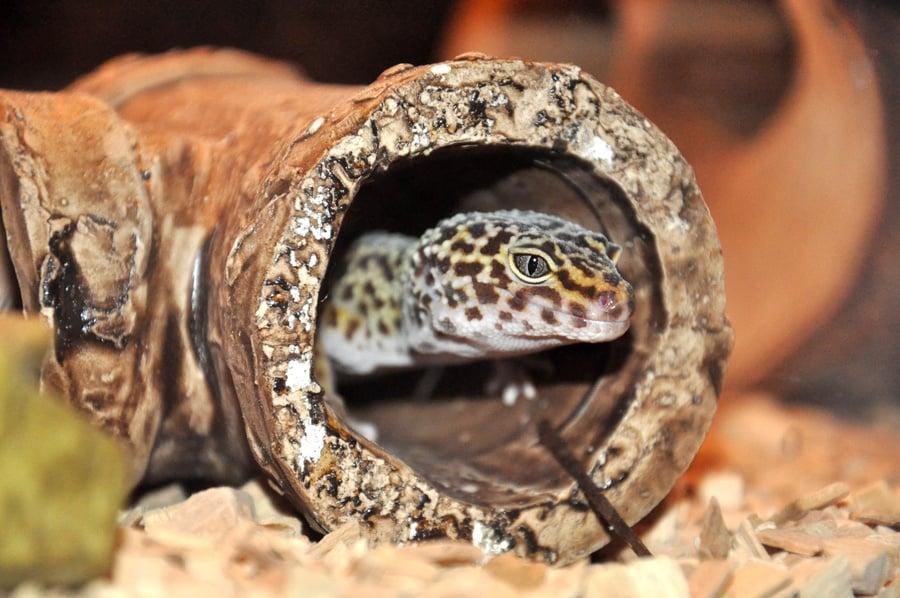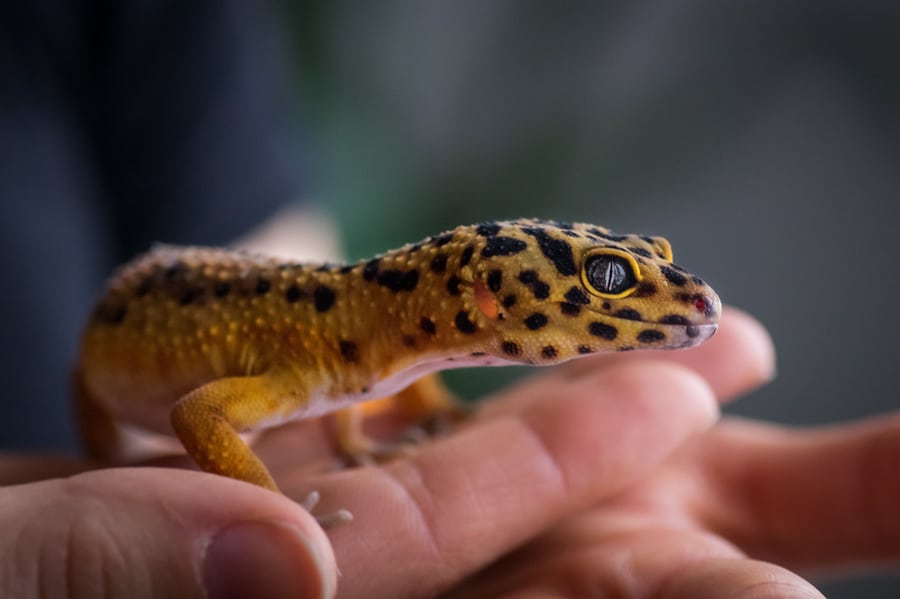
Although leopard geckos are known to be docile, mild-mannered creatures, handling can be a touchy subject. I learned through first-hand experience, they can become easily stressed if handled incorrectly. So is handling your leopard gecko beneficial or harmful?
Handling a leopard gecko can be very beneficial and reduce your pet’s stress as long as you’re not handling too often, allowing the leopard gecko to adapt to the owner’s touch before handling, and giving the leopard gecko opportunity to explore. This can even create a closer attachment between the two, which ultimately strengthens trust.
At the same time, however, the owner should handle their leopard gecko carefully to avoid issues, such as injuries and aggression from stress. Otherwise, it may respond aggressively or nervously to handling, creating a vicious cycle.
Handling & Touching Leopard Geckos
Should leopard geckos be handled?
Oftentimes, owners do need to handle their leopard geckos to thoroughly clean the tank and do regular health check-ups, which are both essential to a leopard gecko’s well-being. They will also need to handle the lizard to properly tame it. As the owner continues to handle the leopard gecko properly, they can develop an attachment and sense of trust, which helps keep the reptile from being stressed.
My personal experience: I felt a deeper bond with my leopard gecko the more I handled it. You will as well.
How often should they be handled?
Preferably, an owner should only handle their leopard gecko about once a week. However, it is fine to handle the gecko up to once every other day for up to 20 minutes per session.
Some may say an owner should handle their gecko daily to “tame,” but this only stresses out the leopard gecko, which is a naturally solitary creature and needs time to rest. Fortunately, leopard geckos can easily get used to and enjoy the owner’s presence without excessive handling, even as babies.
Even though they should not be handled daily, baby leopard geckos do need a little more handling than adults so it is easier to transfer them during terrarium cleaning or perform a health checkup if needed. In this case, the owner may handle the baby once every other day. For babies, the owner should start by having them acquainted to touch (for example, petting the gecko or allowing it to climb on the owner’s hands) while not completely holding them for a week.
Regardless of the leopard gecko’s age, its owner should avoid handling the reptile when stressed. Some signs of stress are clucking, trying to wiggle away, waving its tail, and having tightly closed ears. If the leopard gecko is a baby, it may do these things initially.
Although this behavior is normal for them and may be ignored if done for a short period of time, the owner can give them a break if these issues persist to avoid an unnecessarily unpleasant experience (and tail dropping).
Do leopard geckos bond with their owners?
A leopard gecko can develop a physical attachment with its owner through trust and care, but it will not have an emotional bond. Even with this lack of emotional affection, however, an attached leopard gecko will enjoy spending time with its owner.
When done properly, occasional handling will “tame” the gecko and may help establish trust. Because of this, one may consider the attachment a leopard gecko has with its owner to be a physical bond.
Do leopard geckos like to be handled?
Since leopard geckos are solitary creatures, they prefer to be left alone though exposure to gentle touching can be very beneficial. They will tolerate handling if they trust their owners. As a matter of fact, they are one of the most mild-mannered reptiles, making them a very easy reptile to handle.
Even then, owners should avoid excessive handling, such as cuddling, smothering, and petting sensitive areas. Although they may not lash out if they are tame and not in an overly stressful environment, they will become extremely stressed and grow to dread handling.
How should you hold a leopard gecko?
Before holding the leopard gecko, the owner should ensure that it is aware of its presence, so they do not startle it. One way to do this is by making a soft noise. Once the leopard gecko is aware of your presence, you should loosely loop their hand around its waist.
Then, lift it up. If the leopard gecko is newer to being handled or seems nervous, the owner can start by holding it a few inches above the ground for a few moments, then lifting it completely out of the cage. When handled properly, the leopard gecko will bring its front claws on the index finger and the back claws around the pinkie.
In a comfortable holding position for the leopard gecko, the hand will be mostly vertical with a slight tilt. If the owner is doing a health check-up, they should stroke the leopard gecko’s back to feel for any unexpected bumps (which may indicate a bone break or tumor), look at their toes for post-shed skin, and ensure the leopard gecko has a healthy weight.
If the owner is transporting the leopard gecko to a new area for a terrarium cleaning or vet visit, they should allow the gecko to see its container and slowly bring it down.
Then, the owner can open their hand and allow the gecko to crawl out of it. As a side note, the container should have a top lid and a small hiding spot to avoid escapes or unnecessary stress.
If the handling session is more than a simple transport to clean the cage or health checkup, the owner should allow the leopard gecko to explore. They tend to be somewhat restless from wanting to explore during handling, so this reduces stress and creates a more enjoyable experience.
One thing the leopard gecko can do is climb on the owner’s arms a little or explore the owner’s lap. Also, if the owner is handling their leopard gecko in a safe, enclosed area, they may allow the gecko to explore the area around them.
How should you pet a leopard gecko?
Generally, an owner should only pet their leopard gecko on its back and occasionally its head. Rubbing on the belly or tail causes unnecessary stress and may even cause the leopard gecko to drops its tail.
Before petting the leopard gecko, the owner should ensure that it is relaxed and not in a position where it could get hurt if spooked (for example, being held high above a hard floor). If the leopard gecko seems nervous, the owner should wait for it to calm down or allow it to wander around a safe area before petting it.
To pet the leopard gecko properly, the owner should stroke gently from the shoulders to the hind legs with their thumb or index finger. It should not be pet the other way, as it messes with the gecko’s scales and causes discomfort. Before petting the leopard gecko, the owner should allow the gecko to see their finger and gently rest it on its back before stroking.

Is it safe to hold a leopard gecko?
Typically, handling a leopard gecko is safe for both the owner and their reptile. However, to ensure that it is safe, the owner needs to handle their pet properly using the guidelines previously mentioned.
Owners have low risks in handling a leopard gecko—they are not poisonous, and unless they are improperly handled, under extreme stress, or untamed, they seldom bite. Some people may have a sensitivity to the gecko’s claws when it pricks the skin, creating red itchy spots where the lizard walked.
Although this is harmless and the spots go away soon after, the owner may use gloves or their sleeve to handle their gecko if it is too irritating. On the other side of the equation, the leopard gecko will be safe as long as it is not overhandled and the owner is aware of how to handle it properly.
To be sure that the leopard gecko remains safe, it should be handled in a secure environment without dangers, especially larger pets. Also, if the owner allows the gecko to climb on them, they should be sure that they are aware of where the gecko is at all times.
Finally, they need to make sure that the leopard gecko remains calm during handling at all times; otherwise, it risks dropping its tail.
10 Tips for Bonding & Handling Leopard Geckos
1. Because leopard geckos are nocturnal, the owner should try to handle their gecko during the evening, so they do not disturb their pet while it is trying to sleep.
2. When the owner handles their leopard gecko, they should try to do so at a regular time (for example, 7 PM every other day), so their pet can expect it.
3. The owner should make some soft noises while coming to the terrarium, such as clucking or saying the gecko’s name. This will keep them from being surprised when they pick it up, and it will help them associate certain sounds with their owner.
4. Whatever the owner does, they should never pick up by the tail. If the owner is put in a situation of potentially dropping the gecko, it would actually be better to drop from a short height on a flat surface than to risk them losing their tail. A healthy gecko won’t sustain serious injury from this fall, as long as they do not fall headfirst.
5. If the leopard gecko sprints away from the owner’s hand, the owner should never grab at it, instead waiting for the gecko to calm down before picking it up again. Otherwise, they risk their leopard gecko losing its tail, and the reptile is more likely to consider handling to be a negative experience.
6. To avoid the situation of choosing between a leopard gecko’s tail and potential injury from a fall altogether, the owner should allow the leopard gecko to acclimate before handling for the first time. For example, they may talk to the leopard gecko and allow it to get used to their scent. Later on, they can put their hand in the cage to allow the gecko to explore it (and possibly pet the gecko to help it be comfortable with touch). Once the gecko establishes a strong sense of trust with its owner, it is ready to be held.
7. As mentioned before, the owner should try not to just hold the leopard gecko the whole time. For example, they can also allow their leopard gecko to explore, whether through crawling on their arms or walking around in a safe and enclosed room.
8. Interestingly, allowing the leopard gecko to walk around on the owner’s hands and arms, even if they are not exploring, helps calm down the lizard and lowers the chances of it bolting. Also, the gecko will consider handling to be a positive experience if it does not feel overly restricted.
9. Giving items both to establish trust and offer a reward will not only make handling easier but also encourage bonding with the owner’s leopard gecko. For example, the owner may give food to the leopard gecko after handling sessions as a reward (however, they should keep in mind that a leopard gecko needs to be fed once every other day, preferably around the same time).
10. When holding the leopard gecko, the owner should avoid putting one hand over it. Otherwise, the gecko will feel threatened, increasing the risk of it trying to get away.
Conclusion
Although leopard geckos are well-known for being docile during handling, owners also need to develop a bond and sense of trust with them, so the reptile can have a positive experience. This way, the owner is able not only to have an enjoyable experience during holding, but also able to move the gecko easily for cleaning, check-ups, and (worst-case scenario) health emergencies that may arise. Because of this, proper handling and bonding are essential to the leopard gecko’s health and well-being.
For a complete breakdown of how reptiles bond with their owners, please check out this helpful guide.
